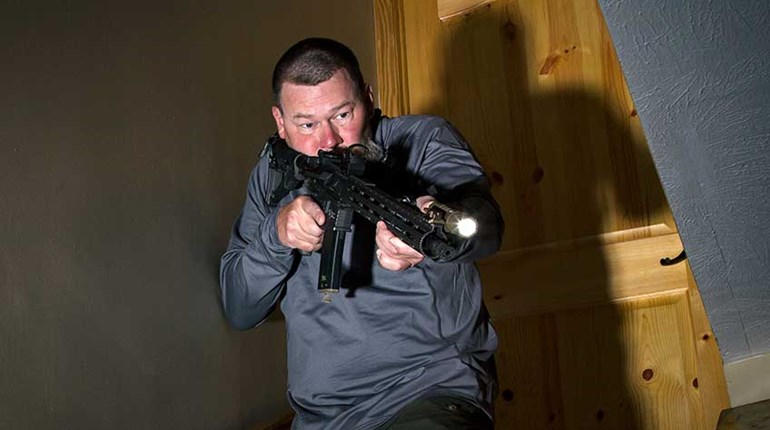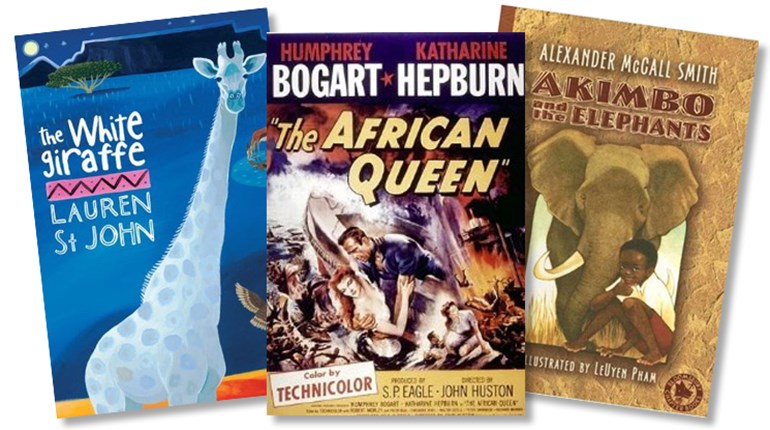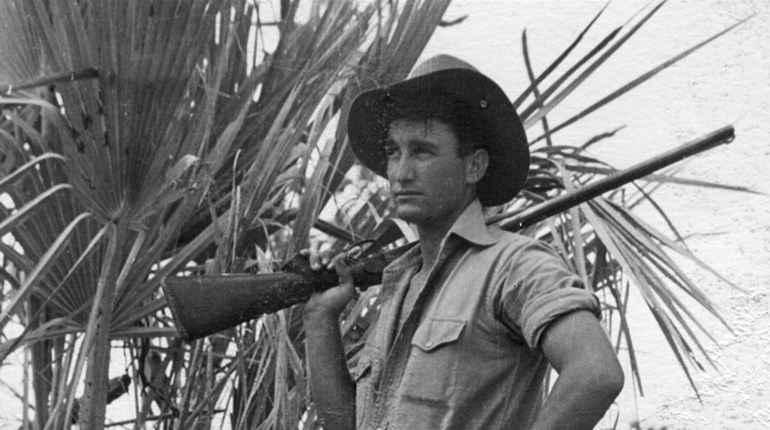
When you glass across the rolling hills and cliffs of the Erongo Wilderness area, you are lulled into a false sense of security, a belief that you just might enjoy ease of movement and Wyoming sagebrush hillside familiarity. The only perceived differences are the sightings of mountain zebra, kudu and an occasional baboon barking insults and warnings your way. But when you finally step off into the abyss that is Erongo, you are sucked into hellish thorns and misshaped rocks. This isn’t Kansas, Toto, and definitely not Wyoming.
The thorns almost reach out and grab you; the appearance of sagebrush is soon forgotten as most of the “stop-right-there” bushes are 10-12 feet tall. The rocks are so plentiful and odd that you could walk across the Erongo without touching the ground—that is, if you have superb balance and stronger ankles than me. The devilish terrain is deceiving as you trudge up a slope you perceived as easily conquered, which then degenerates into a cliff band that is completely impassable.
■■■
The mission at hand was to backpack hunt the mountains of northwest Namibia, living in the bush while chasing free-range game through the wilderness areas of southwest Africa. From the moment I stepped into the bush with John Wambach from Link’s Wild Safaris and Pro-Hunting Namibia, I was a happy camper.
 Happy and ecstatic, however, are two different creatures. I was having a good time but continued to be jerked back to reality as thorn bush after sticker tree was parried with a walking stick as though fighting with the masked man in the old movie “The Princess Bride.” I quickly realized my swordsmanship required some fine-tuning as time and again the enemy limb would swing free then come back with a vengeance, often removing headgear and sunglasses, or simply embedding in any small area of exposed skin. To make matters worse, it seems the pants I had chosen to wear had a special sticker attractant impregnated into the material. I normally wear 5.11 Taclite pants, which are bomber and repel stickers, but for this trip I had grabbed a lighter pair of pants with a little stretch built in. Five hundred yards into the mountains, my legs looked like the south side of a northbound porcupine.
Happy and ecstatic, however, are two different creatures. I was having a good time but continued to be jerked back to reality as thorn bush after sticker tree was parried with a walking stick as though fighting with the masked man in the old movie “The Princess Bride.” I quickly realized my swordsmanship required some fine-tuning as time and again the enemy limb would swing free then come back with a vengeance, often removing headgear and sunglasses, or simply embedding in any small area of exposed skin. To make matters worse, it seems the pants I had chosen to wear had a special sticker attractant impregnated into the material. I normally wear 5.11 Taclite pants, which are bomber and repel stickers, but for this trip I had grabbed a lighter pair of pants with a little stretch built in. Five hundred yards into the mountains, my legs looked like the south side of a northbound porcupine.
We hiked into the mountains from a remote trailhead, carrying all that we owned on our backs. This normally wouldn’t be a difficult task if heading into the hinterlands of Montana, but in the Erongo there is absolutely no water this time of year so with 9-10 liters on board your pack becomes heavy. We also needed to carry our tents, not for rain or snow but to keep the snakes from cuddling for warmth during the night. I gladly packed a tent; no need for any additional sleeping-bag visitors on this trip.
For armament I had selected the Christensen Arms Summit rifle chambered in .300 WSM. On it I mounted a Zeiss Conquest 3X-12X-50mm scope with an illuminated reticle, but I would never even turn it on during this trip. It seems the sun always shines in Namibia.
To carry my spike camp, I used a Stone Glacier Sky 5100. This pack has the best features you will find in the lightweight hunting market. Weighing only 4 pounds empty and allowing for complete compression whether full or stripped for day-hiking, it is an effective solution to problems that have plagued backpack hunters for years.
■■■
Day one found us trekking into the mountains with our entire camps on our backs. The intent was to find a satisfactory spike camp and then conduct day hunts from there. The only problem we faced on day one was the number of kudu we encountered straight away. It seemed as though the rut had started. Cows were herded up and bulls were in pursuit. This was good news but caused a pretty significant detour on the way to finding a camp.
But even though we chased the kudu over a couple craggy ridgelines we couldn’t get in range of the old herd bull we had spotted. He was a dandy and would require more hunting in the next day or two. So about midday we stumbled into camp, dripping with sweat and nursing sore feet. We found a spot that allowed us to set up tents on relatively flat ground. Our team included professional hunter John Wambach, cameraman Matt Young and me.
As we fought to stay in the shade during the hottest time of day, we laid around like a bunch of Cape buffalo, swatting flies and drinking water. We discussed everything from politics to the evening’s hunting plans. John is a former Special Operations soldier who fought in Namibia during the communist insurgency. We had some very frank discussion about his thoughts on the past and the future. It is a crazy world we live in.
Later in the day we saddled up and headed to a ridgeline within 500 yards of camp. It was nice to have a lighter load and feel the wind in our faces as we picked our way to an elevated glassing position. As soon as we sat down we realized there were at least a dozen mountain zebras just below our vantage point. But we had set our sights on kudu so we didn’t even begin to entertain the idea of chasing zebra just yet. (In a few days we regretted this decision.)
As the sun started to disappear the beauty of Namibia came into complete focus. It seemed as though the heavens were alive with more stars than I have ever seen in one nighttime sky. John knows more about celestial activity than most. He pointed out numerous constellations that are either not visible in the Lower 48 or just difficult to see around the parts of the country I frequent. John also pointed out Venus and its moons that were slightly visible with a Zeiss bino but stood out perfectly when viewed through his Leupold spotting scope.
I must admit, the first night of sleep wasn’t spectacular. I tossed and turned thinking about the next day’s adventure, and every now and then I heard sounds uncommon in hunting camps out West. At one point, a herd of zebras walked within 50 yards, their hard hooves distinctively clicking on the rocks as they strolled by our quiet camp. This was good living.
The next morning, we started with coffee and oatmeal heated on a Jetboil—just enough to fuel the engine—and away we went. Before the sun could heat up the bush we were on our way to chase kudu. Within 30 minutes we heard a kudu bull bark his disagreement with the invaders he smelled walking through the bush. We did get to see him, but he wasn’t what we were looking for. So keeping the wind in our faces, we made it to a point of high rocks on the side of a mountain and sat down to tear apart the countryside with our binoculars. It is much easier to cover large tracts of thorn bushes with your eyeballs than with your feet. The bush was extremely thick and unforgiving, so we welcomed the perch to see what we could see.
Within minutes we spotted a herd of kudu also governed by a small bull—we also found a threesome of klipspringers that seemed aware of our presence. And within the hour our presence on the hillside also surprised a troop of baboons. Their alarm barks startled us as we realized they were within 30 yards of our position. One proudly sat in a tree and gutsily talked trash for a bit before making an acrobatic departure.
The ensuing mayhem of the baboons’ departure stirred up more kudu movement below our position. We finally were able to dissect the thorn bushes with the Zeiss glass and pick out movement of another group of cows; this time our patience was rewarded as we finally found the bull we were after—a bull head-and-shoulders bigger than the others we had seen. His massive, twisted horns pointed toward his direction of travel and were highlighted with ivory tips—both were telltale signs of maturity.
But as we moved into a position that allowed for engagement of this magnificent animal, two things happened that curtailed the immediate action. First was the range call from John through his Swarovski binocular. The distance was almost 500 yards, and I quickly realized it was on the extreme border of what I perceive as an ethical hunting shot. Secondly and even more importantly was the call of nature. As per SOP (military slang for standard operating procedure), the freeze-dried diet was about to rear its ugly head, and we all know there is no ignoring that.
But with a great bull chasing cows below, we solved both problems, continuing to move laterally along the hillside looking for a sucker hole to shoot through. At last we found a rock pile vacated by the baboon troop (and apparently free of snakes as well). After kicking baboon scat out of the way, we settled in to glass.
The distance had been reduced to around 380 yards. Now we focused on an area that provided fleeting glimpses of kudu cows and every now and then the bull. But before we could make the shot, the bull decided to feed and then bed just behind a thick thorn bush. The cows were a little more cooperative, feeding into an open area with a wide-open shooting lane. I have been in a few waiting games with animals and I really enjoyed this scenario. Still, the bull took his sweet time grazing and resting before finally giving us a show. He raked the bushes and scratched his back with his massive horns and finally, after almost five hours of waiting, he stepped into the open.
By then I had assumed a perfect shooting position with a section of Ridgerest sleeping pad to make it a little more comfortable as I rested the rifle across the Stone Glacier pack. But I had not dialed the elevation change into the scope; I would hold at the top of his back since my ballistic program had told me there would be almost 15 inches of drop at 380 yards, and such a hold would allow the bullet to, I hoped, dissect the vitals. There was also just enough wind to cause an estimated 3-4 inches of bullet drift, so this was considered as well. The last consideration was the position. I couldn’t comfortably get into a right-handed position, so with years of practice under my belt I chose to shoot left-handed. Many wouldn’t feel comfortable making this change, but I practice this almost every trip to the range for occasions just such as this.
When the rifle fired I felt completely comfortable with the shot and was quickly rewarded with a hollow thumping sound of the bullet’s solid impact. I quickly jacked another round into the chamber and shot him again with another 165-grain Hornady GMX. The first shot had been good but with terrain like this we didn’t want the bull moving any farther into dinosaur land. And then, shortly after the second bullet’s impact, the bull swayed and crashed to the ground.
It was an unforgettable experience but now the work began. We picked our way down the mountain and walked up to the massive beast with a neck swollen from the start of the rut. His horns dwarfed any kudu I had ever shot in the past. We quickly snapped a few hero shots and started the butchering process, trying to beat the sun. As I strapped the head and horns to my pack, the sun reddened the western sky, making the dry grass and thorn bushes glow. It was beautiful, but as soon as I became stuck in the first thorn bush with more than 50 inches of horn above my head the scene quickly lost its luster.
By the middle of the night we had secured the meat in John’s truck and were happily off to his main camp. Once there we showered and spent the night before heading out on the next quest for mountain zebra.
■■■
After seeing plenty of zebra the previous few days, I optimistically had figured we would make quick work of the disco donkey and be back at our spike camp before dark. But this would not be the case. It seems the previous day’s activities had cleared out the area and we couldn’t buy a zebra sighting. We did spook a couple as we crested a cliff, but they made a quick getaway before I could get settled in to shoot. By evening we were pretty much ready to sit around camp and enjoy the night sky as we chowed down on another freeze-dried meal. The sunset was again an amazing dark red that lingered into the night. With this sky overhead it didn’t take long to rack out and hope for a better day of hunting tomorrow.
We were up early, downing coffee and granola to get the motor running and then breaking camp to move to greener pastures. We planned to hunt for zebra as we slowly made our way to the trailhead. There really wasn’t anything significant to report other than a few hyrax, or rock rabbits as some call them—the equivalent of an American marmot or rock chuck. The locals told me the hyrax is the closest known relative to the elephant. I’m not sure if this is legend or fact, but I just didn’t see the resemblance to any tusked cousins.
As we struggled through the rocks and thorns toward the trailhead, I couldn’t help but see the beauty in this devilish landscape. With all the harshness Mother Nature can offer, the hills around us were full of wildlife—other than zebra, that is. We were pretty smoked by the time we reached the trailhead, so we put up a poncho for shade and awaited cooler temperatures. Since we were by the truck and had plenty of water we drank plenty of it. Plenty of baboons harassed us, too, but after a while you get used to that.
When the afternoon started to cool we dumped our heavy packs, keeping only what we needed to trek around the high ground close to the trailhead. John had decided that we would make a loop on foot then see what happened next. We spotted more klipspringers and even one snake but not a sign of oryx or zebra. As though we were walking on the surface of the moon, at times the rocks were beautiful and plenty. We climbed across cliffs and glassed, hoping to see the white dots of zebras, and after several hours headed back to the truck and called it a day.
That night we feasted on steaks from the backstraps of the kudu I had shot. John used a disc blade from an old farm implement to cook on and added only onion and oil. The meat was wonderful, with a texture and flavor that I would compare to elk. It was a grand occasion. After eating until we were sick, we wandered off with hopes of a good night’s sleep and the miracle of spotting a zebra the following day.
As the sun started to warm the desert the next morning, we stopped occasionally to peek over rock cliffs to the landscape below, hoping to catch some unwary zebras. We continued to work our way farther and farther into the wilderness when finally our cliff checking paid off: four zebras were below us. Problem was they were a long way off and making tracks. But as we began discussing our next move, we heard a whinny come from below us just around the corner of cliffs.

John checked to see that our ears weren’t playing tricks on us, and sure enough, there was definitely a mountain zebra below us. I slowly slid out onto the large rock on my butt, feet first. My plan was to shoot with the Summit rested across my toes as I have practiced religiously. Not but 200 yards away and well below me was a zebra mare.
Zebra stripes produce an aiming point that perfectly covers the animal’s vitals, but with the extreme angle I knew I needed to make the bullet enter slightly higher to bisect the heart and lungs. And with the zebra being a notoriously tough critter, I wanted to make sure this gal hit the ground fast.
Sure enough, the 165-grain GMX did the trick quickly. The Christensen is light so I was ready for the kick (although I realized later I hadn’t noticed it at all).
It was a pretty hairy climb down to her, and there was plenty of work to be done skinning and quartering the mare. But the climb out was even worse. We ended up scaling a cliff with just a little too much weight on our backs. Once back at camp it seemed like it wasn’t a big deal, but as I was hanging 10 I wasn’t talking trash—that’s for sure. I’m not built for rock climbing so I forgot about the snakes in the rocks and elevated self-preservation to the top of my to-do list.
■■■
The next morning we spotted a very nice oryx from the rocks by our camp. We had to drop all of our gear to move within range, but it made sense since the group it was with was only 600-700 yards away.
Once in the brush we couldn’t see anything and had to rely on John to get us to the right area. We found a small, open area that I guessed was around 100 yards from where we had last seen the antelope. I had the scope dialed down and stayed vigilant behind the Christensen Summit. I really didn’t believe the oryx would feed directly toward our hide site but sure enough after we stood in postion ready to shoot for 45 minutes, they plowed through the thorns directly to our front. I looked at the first animal and he was healthy, and when I looked at the second he was more well-endowed than the first. The shot was 60 yards straight from the front, so I squeezed it off and the oryx bolted. I felt sure it was a good shot, and as we moved up the blood trail became significant. Then, after 30 yards, we found him dead as a hammer in a big brush pile where he dived with his last burst of life.
Outfitter
To book a backpack safari with John Wambach of Pro-Hunting Namibia, contact Link’s Wild Safaris.






































